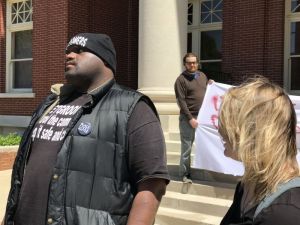For former Fayette County resident Connie Biemiller Thomas, it was a journey that began in the summer of 2006 and ended earlier this month. The journey involved the advocacy for her community in the wake of a chemical release that affected more than 2,000 households in Fayette and south Fulton counties and ended with a recommendation by a national panel that the federal government establish the national Office of the Chemical Emergencies Coordinator to serve as a clearinghouse for communities to access when they are exposed to releases of industrial chemicals.
The Chemical Emergencies Work Group for the National Conversation on Public Health and Chemical Exposures is a program of the federal Centers for Disease Control (CDC) and the federal Agency for Toxic Substances & Disease Registry (ATSDR). The 30-person panel of which Thomas was a member was made up nearly exclusively of government, industry and academic members. The panel was charged in 2009 with determining how the U. S. can meet public health goals and achieve the ATSDR/NCEH (National Center for Environmental Health) vision that the United States will use and manage chemicals in ways that are safe and healthy for all people. There are nearly 90,0000 industrial chemicals marketed in the United States, many of which are toxic.
A clinical social worker by profession, Thomas said the impetus for the National Conversation came about after hearings in the U.S. House of Representatives on the inadequacies of ATSDR nationwide. Asked if she knew why she was selected as one of only two community members, Thomas said she had received a number of nominations and that she had been rather vocal at the panel’s kick-off meeting in Baltimore.
One of the recommendations held that the federal government should establish or identify an Office of the Chemical Emergencies Coordinator to serve as a central repository for information on chemical emergencies and to coordinate governmental chemical emergency efforts. According to the recommendation the office should:
• Integrate the frequently disparate data developed by federal agencies before, during, and after a chemical emergency, and proactively disseminate data to planners, responders, and, as appropriate, the public via a National Clearinghouse for Chemical Emergencies;
• Collect, develop, and disseminate toxicological information tools;
• Inform communities, first responders, and first receivers about current and past storage, use, spills, and releases of toxic chemicals in their areas, as well as information on hazardous activities and agricultural activities involving chemical uses;
• Receive reports of chemical emergencies and coordinate timely responses through referrals to the agencies with proper jurisdiction;
• Ensure that responders at all levels have access to real-time information on regional resources and response capabilities;
• Take advantage of the lessons learned from the national system of Poison Control Centers.
An additional recommendation noted that, “The President should issue an Executive Order or Homeland Security Presidential Directive that articulates an overarching national vision for addressing chemical emergencies; and each federal agency should develop its own supporting strategy to prevent, prepare for, respond to, recover from, and mitigate chemical emergencies and ensure that a preparedness momentum is maintained.”
It was Thomas at one of the panel meetings who initiated the idea of establishing the national clearinghouse.
“The idea for the national clearinghouse came to me while I was on a conference call with some of the participants on our work panel. All I can say is the idea just suddenly coalesced in my mind and it was immediately received as a workable idea by the rest of the panel, You could feel the excitement in the air. It was also providential that one of the panel members representing Yale University happened to be pivotal in starting Poison Control so the two of us began to hammer our the national clearinghouse recommendation and saw immediately its natural fit into the Poison Control model resulting in less funding needed by just expanding this entity,” Thomas explained.
“It was the number one recommendation of our work group and, once finalized, left our hands to go to the Leadership Council of the National Conversation,” Thomas continued. “Weeks later, they came out with their proposed final document and when I saw that the national clearinghouse was not included in their overall top recommendations, I again had to take a stand. I called to make sure I was included on their next committee conference call and took a stand for the national clearinghouse once again. By the end of the several hour meeting it was included at the top of the list. I held my breath in the weeks to come to see if it really was going to make it into the final report, and was absolutely overjoyed to see that it was.”
Her nomination to the National Conversation panel was the result of actions Thomas undertook in the summer of 2006, actions that continued for the next several years on behalf of the communities of Fayette and south Fulton.
It was in the opening days of July 2006 that Thomas set up a card table at the corner of Lee’s Lake Road and Rivers Road in north Fayette. Taped to the table was a sign asking if anyone had been “smelling onions.” They had. It was soon shown that communities surrounding the Philip Services Corp. waste treatment plant about a mile away were being blanketed with a thick, onion-like odor that quickly proved to be far from anything organic. The odor was soon shown to be the chemical odorant propyl mercaptan that is used in combination with the organophosphate pesticide MOCAP.
Thomas and a group of residents, all ill from the effects of the chemical, quickly formed the South Fulton and Fayette Community Task Force. Though they initially received virtually no support from ATSDR and the Georgia Division of Public Health (DPH) or any state or federal agency, the task force continued to press for answers to the hundreds of illnesses that were documented in a 40 square-mile area.
Local emergency response agencies in early July initially noted complaints of the “onion odor” from Hartsfield Airport to the east, Newnan to the west, the central portion of south Fulton to the north and Sharpsburg, Peachtree City and Fayetteville to the south. The sometimes thick odor of mercaptan lingered for months in the 40-square-mile hot zone of north central Fayette and east of I-85 in south Fulton.
Some of those affected filed a class-action lawsuit that was settled out of court for $4 million. The settlement included more than 2,000 households in a three-mile radius of the PSC plant.
And for their part, ATSDR and DPH released a Health Consultation that acknowledged that community members had experienced short-term illnesses from the chemical exposure. The illnesses were consistent with the symptoms of both acute and chronic exposure to the pesticide and chemical odorant.
For her part, Thomas and some on the South Fulton and Fayette Community Task Force continued to press for a way to have residents across America informed in a timely fashion when their communities were exposed to chemical releases. Thomas and other task force members were seen by some as a troublemakers and to others as those who would run the risk of standing up for neighbors and strangers.
Another task force member was Lois Speaker, a chemist who also served as the organization’s science officer. The Peachtree City resident applauded the June clearinghouse recommendation.
“We use endless numbers of chemicals every day. They are often extremely powerful materials and most people possess little awareness on how to control them, to identify the risks they pose and how to respond after being exposed to them,” Speaker said. “And like most people, most communities are also helpless.”
Though many were sick, the local task force continued to meet and continue speaking out for the children and adults that continued to breathe the onion odor that persisted in the community well into the fall of 2006.
Efforts initiated by the task force, with the crucial assistance of Fulton County Commissioner Bill Edwards, led to PSC’s withdrawal of its wastewater permit application, a move that essentially shut down most of its operations. PSC later settled the class-action lawsuit out of court.
“Our community story has made a huge impact in the lives of millions of people just by our willingness to take a stand and form a task force. The task force of community members saw the big picture and was willing to stick together beyond the local circumstances and fight for change,” said Thomas. “That willingness has now propelled our story into the national realm of thought. And, the opportunity is now before us bring about change not only to protect our present citizens but generations to come.”
It remains to be seen if the recommendations of the Chemical Emergencies Work Group will be seriously considered by the administration in Washington or among federal agencies.
“If enacted, these recommendations will allow citizens to receive immediate information as to how best protect themselves when a chemical emergency occurs in their area,” Thomas said. “The goal is to expand Poison Control to incorporate learned scientists and community workers who would have immediate knowledge of the target chemical and best practices on how to mitigate and protect the community once exposed.”
And if enacted, what would citizens gain?
“The National Clearinghouse for Chemical Emergencies would turn scenarios like we saw in Fayette and Fulton counties around and walk the citizen through the process and advocate for appropriate measures to be taken within the community on the citizen’s behalf,” Thomas explained. “The National Clearinghouse would not be beholden to any government or corporate entity. It’s funding would come through various government channels but would primarily serve as a non-profit much like Poison Control works now.”










Leave a Comment
You must be logged in to post a comment.